Cathodic Protection of Steel-Framed Buildings
Chris Wozencroft
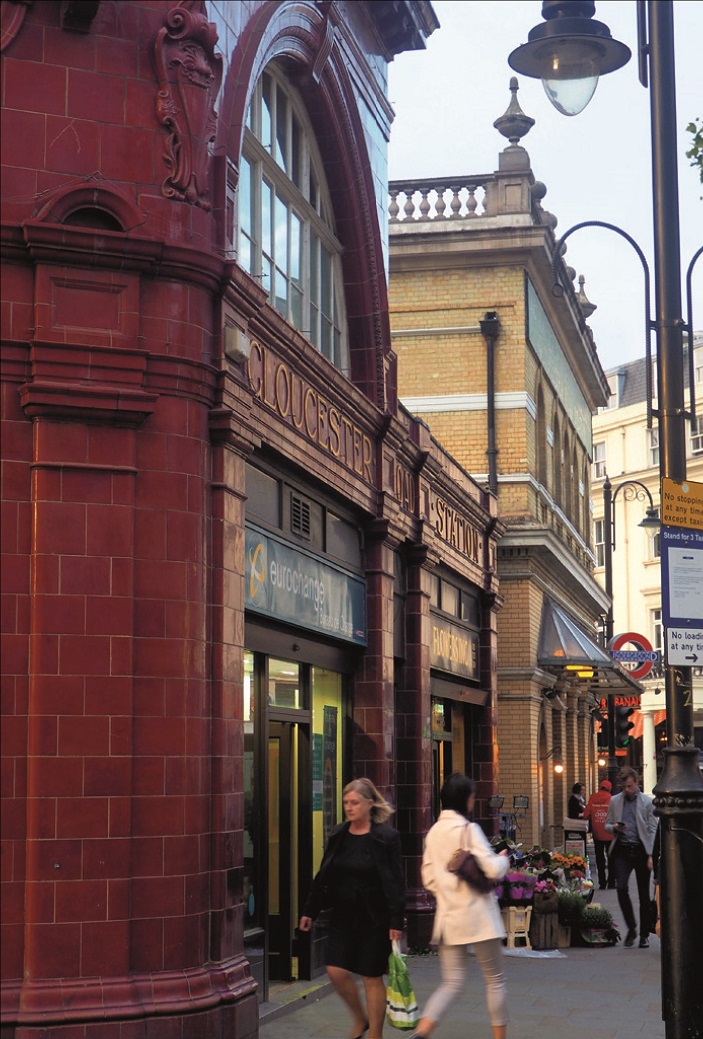 |
| Fig 1 Gloucester Road, one of many London Underground stations built in the early 20th century with a steel frame clad in glazed terracotta blocks and a breeze concrete fill |
By the late 19th century advancements in building technology had enabled multi-storey and high-rise buildings to be constructed. These impressive buildings had structural skeletal frames made from steel and iron, with external masonry cladding forming a weather barrier. After about 1895, architects and engineers started to design these structures with the cladding tightly built around the metal frames. Although this form of construction has several advantages (such as the extra rigidity given by the bracing of the infill walls) with age the masonry became vulnerable to the corrosion of the embedded metal frame because the corrosion product, rust, is approximately 7–11 times the volume of the steel it replaces. Even relatively low levels of corrosion and section loss can therefore lead to large levels of cracking and displacement of masonry (figure 2).
The problem has been termed ‘Regent Street Disease’ due to the high density of early 20th century steel-framed buildings in this area of London, although the same decay mechanisms also affect other types of structures, including older masonry buildings where iron and steel fixings (such as cramps) have been used.
PREVENTION & TREATMENT
In many cases, Regent Street Disease can be diagnosed early and prevented by controlling water ingress and the moisture content of the masonry. Regular survey and maintenance of drainage systems, roof coverings and/or flashings is the first place to start.
In some cases, porous brickwork cladding has been successfully treated with siloxane water-proofing to the extent that Regent Street Disease in the brick-clad parts of the building has not appeared. However, making the surface of masonry waterproof can have significant detrimental effects. Not only can it lock moisture into a structure, but it also affects the physical properties of the surface, causing some types of stone to spall.
Prior to the 1990s, advanced Regent Street Disease was treated by removing external masonry to allow the corroded metalwork to be cleaned and painted with a protective coating. This approach is not only very expensive, noisy and disruptive, but the time required to have extensive scaffold in place often makes it unfeasible. Furthermore, the removal and replacement of the masonry risks extensive damage to the original cladding. Due to the high proportion of new material required, this is generally considered restoration not conservation, conflicting with widely accepted conservation principles. Even if removal and replacement is acceptable, many original materials are no longer available, often because the quarry is no longer in operation or because manufacturing methods have changed. For example, new Carraraware terracotta was, until recently, almost impossible to source and now only one or two manufacturers can replicate it.
CATHODIC PROTECTION
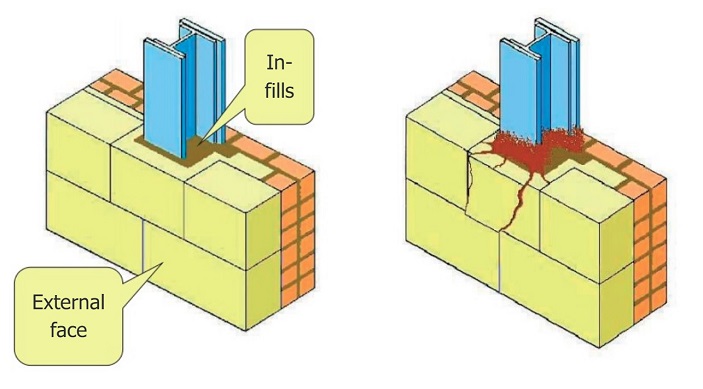 |
| Fig 2. Embedded steel work and the effect of corrosion |
Cathodic protection as it is known (CP), began to be used as a treatment for Regent’s Street Disease in the 1990s and since then at least 100 buildings of different scales, cladding and historical importance have been protected. The technique involves a series of electrodes
(anodes) being installed into the building’s masonry. Where successful, this reduces corrosion to negligible levels.
At its basic level, the principle is the same as attaching a more reactive metal to the hull of a ship so that this corrodes sacrificially, thus preserving the parent metal. Although such ‘galvanic’ systems have been installed to some natural stone structures, in practice they are not generally capable of protecting against Regent Street Disease. This is because the cladding of most steel framed buildings has such high resistivity that the lower voltages of galvanic anodes cannot emit, or distribute, the required level of current. A modified form of CP is therefore used whereby a DC current from a power supply is used to activate otherwise inert metal anodes.
Another advantage of using an impressed current system such as this is that the current can be varied. Extensive experience of monitoring systems protecting this sort of structure shows that, in many locations (particularly the north west) seasonal variations require frequent alterations to the level of current being delivered. This is only possible with a controllable impressed current system.
It is also common for galvanic anodes to be physically larger than impressed current units, which is an issue when trying to limit heritage impact by, for example, fitting them into narrow masonry joints.
A disadvantage of impressed current systems is the frequency of monitoring required. According to published guidance, all CP systems require some level of monitoring, but the risks from excessive outputs are particular to impressed current. So long as the design and procurement of the system ensures that the control equipment has ‘open source’ functionality, the monitoring of the system can be tendered on an annual basis and thus market competition keeps costs low.
Essentially, each type of system and what features it has is a case of ‘horses for courses’. A qualified, independent engineer should be appointed to review the structure, its condition, the available budget, proposed service life and planned access. From this they can determine which form of CP, which products and which installation approach is most suited to the building and the client’s needs.
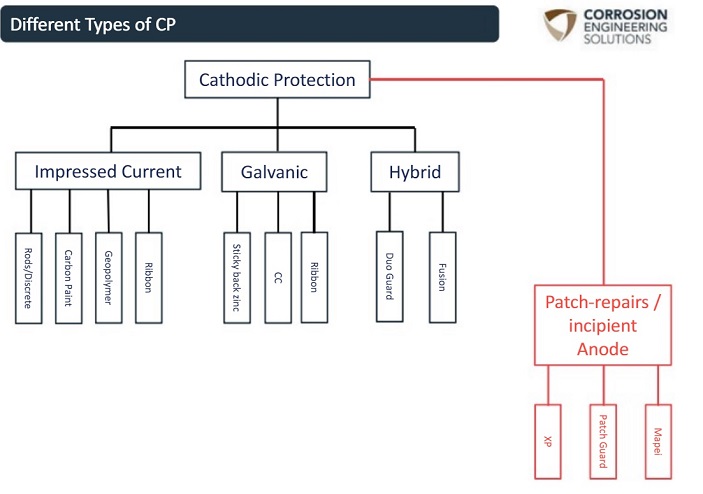 |
| Fig 3. Common types of cathodic protection Those procuring CP are sometimes confused by the similarity of systems which are designed for very different uses. The category shown in red are technically galvanic anodes, but they are shown separately as their purpose is not to protect the structure, but to ensure the long term durability of isolated concrete patch repairs. These are rarely applied to steel framed buildings |
TYPES OF ANODE
Choosing the most suitable anode is also important. Cheap and effective solutions for the deck of a reinforced concrete bridge are carbon paint or a thin titanium wire mesh with concrete overlay. These would not, however, be appropriate for historic masonry, as the façade would effectively be covered in a black paint or sprayed concrete. To minimise visual impact anodes are usually inserted into the existing fabric, as either ribbons which can fit between masonry joints or rods which can be drilled into the masonry.
Mixed metal oxide (MMO) coated titanium ribbon is a relatively cheap form of anode as there are many suppliers of quality products. However, where steel members are buried deep in the wall, ribbon is sometimes unable to deliver the current to all the surfaces, as it is usually installed parallel with the surface of the masonry, typically either in a masonry joint or under interior plasterwork. An example is where a system is being installed from the internal face of the wall, which is often an excellent way to combine work with internal fit-out, reducing the cost of scaffold access and minimising disruption to the heritage facade. The downside is that, in most cases, only discrete rod anodes will be able to deliver the current deep into the masonry to protect the outward facing aspects of the steel frame.
As with all good engineering design, the health, safety and environmental risks should also be assessed when choosing the type of anode. Rod anodes require many holes to be drilled which comes with handarm vibration considerations. Ribbon requires long lengths of deep chasing and, although grinder work is generally safer, grinder accidents are usually very severe.
The designer should also consider innovative products such as geopolymer conductive mortar. What information there is suggests this will be a good solution for many situations but there is (presently) only one supplier and single source procurement rarely achieves good value. From a health/ safety perspective it carries similar risks to ribbon anodes, since installation usually by chasing in shallow channels which are then filled with the mortar.
Considering the number and variety of anodes available, and that most have been shown to be effective in the right situation, the owner should be wary of advice from the supplier of only one type or brand of anode. They may claim it will solve every problem but there may be a better, cheaper solution out there.
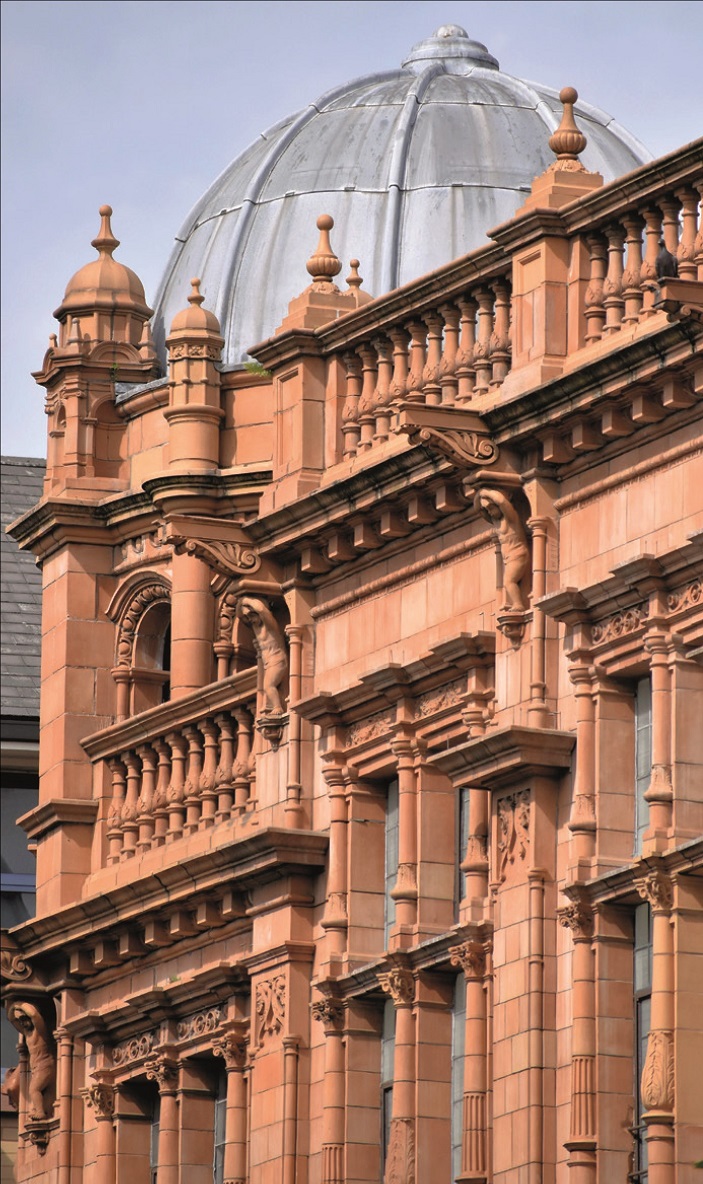 |
| Fig 4. A detail of the Boots Building (now Zara) which opened on Nottingham’s High Street in 1905: its terracotta clad steel frame is now protected by a combination of rod and ribbon anodes |
TYPES OF STRUCTURE
Schemes have been successfully developed for steel-framed buildings with a wide variety of cladding, including sandstone, limestone, glazed terracotta, render and brickwork. The metalwork protected has included embedded columns, beams, support angles, cantilevered beams and cornices/hangers.
Late 19th- and early 20th-century terracotta structures are particularly vulnerable to steel frame corrosion because the light breeze concrete used to fill the hollow pots was rich in soluble salts, so water which finds its way in is rich in electrolytes, encouraging corrosion. One of the first to be protected was the London Underground station at Gloucester Road (figure 1). This is a red glazed terracotta tile facade, typical of railway architecture of that era. And many other glazed terracotta facades have been treated with CP, including the Boots Building in Nottingham (figure 4). This building has a series of iron and steel beams and columns protected using a combination of discrete rod anodes and ribbon. The system was installed from both the inside face and external masonry joints, to maximise the access and effectiveness.
WHO SHOULD BE DOING WHAT?
The owner should carefully consider who they get to design and/or install a CP system. Fortunately, there are qualifications to indicate who is, or is not, qualified for any given activity within a CP project. BS EN ISO 15257:2017 clearly defines these qualifications and, in the UK, there is a compliant training and certification scheme run by the Institute of Corrosion.
The certification scheme has four sectors which can loosely be summarised as marine structures, buried structures, reinforced concrete, and the internal surfaces of tanks. The reader will notice that there is no category for ‘early 20th century masonryclad steel-framed buildings’. It is generally accepted that the reinforced concrete category is broadly applicable. However, while the general principles and products are similar, designing and installing CP to fight Regent Street Disease requires a detailed understanding of the materials and construction type, as well as a sophisticated approach to heritage and design coordination. Someone who is an expert in protecting 1960s concrete bridges is unlikely to have the required experience to tackle an early steelframed building without assistance. Using a contractor who has installed a similar system, on a similar type of building, can often save much time, hassle and money.
LONG TERM PERFORMANCE AND MAINTENANCE
All CP systems require monitoring to some extent. The nature and frequency of the monitoring will be dependent on several things:
• criticality of the structure
• the historic significance of the materials
• type of control equipment
• location of the structure
• likely seasonal variations in moisture and sunlight.
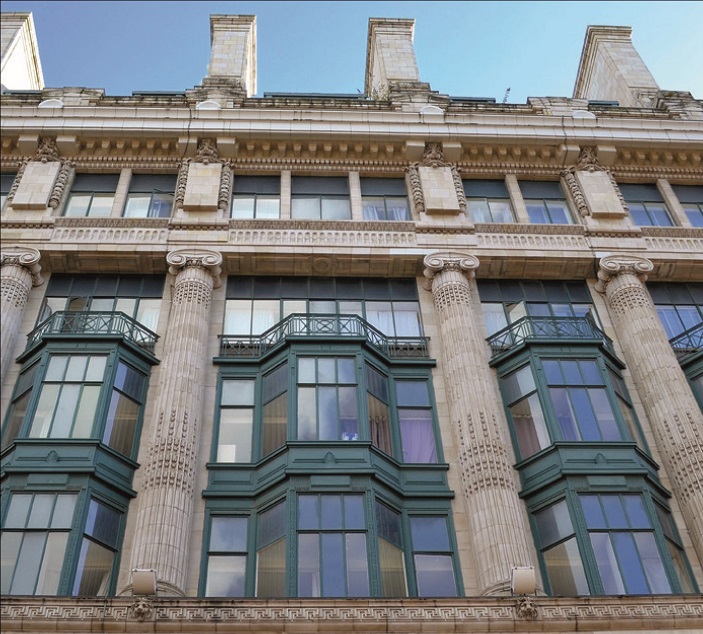 |
| Fig 5. Orient House, Manchester |
BS EN ISO 12696:2016 gives clear guidance on what monitoring is required and when. As this is a standard, it is the baseline in the absence of any other consideration. A more sophisticated discussion of monitoring is presented in the Corrosion Prevention Association’s Technical Note 17. The summary is that the designer should specify the monitoring requirements, and these should be minimised as far as can be justified.
In some cases problems arise because wellmeaning owners have only partially monitored the CP systems, have used unqualified people, or have misplaced the annual reports. Although this has sometimes led to physical damage to the system/structure, problems are more likely to arise when the building is sold or leased and the new owners ask for the monitoring records. If these are inadequate or incomplete, the purchaser’s representatives have, in recent times, started to ask why and to demand compensation.
On a more practical and positive note, the major reason to monitor the CP system is so that the owner knows the structure is protected, that the system’s life is being maximised, that any faults are identified, and maintenance can be planned well in advance.
Many buildings were treated with CP in the late 1990s and early 2000s. They are now reaching the stage where first major maintenance is required. In some cases, the DOS and floppy-disk based control equipment is beyond economic repair, or the reference electrodes have reached the end of their service life. In recent years several buildings have had programs of work which have included an overhaul of the CP system. This has ranged from a few thousand pounds of work to back-up the aging IT of the controllers and re-pointing a few metres of anode, through to large contracts to refurbish the system and extend its service life by several decades.
Orient House, in the Sackville area of Manchester, was successfully protected in the early 2000s using ribbon anodes placed in the masonry joints (Figures 5 & 6). However, by 2017 the CP system was in need of upgrading and the new owner saw the opportunity to also renovate the CP system, for a manageable cost, while carrying out a programme of facade cleaning, window repair and waterproofing. Most of the system was intact and, with the provision of new monitoring sensors and modern control equipment, the system was effectively re-commissioned in 2017 to maintain ongoing protection.
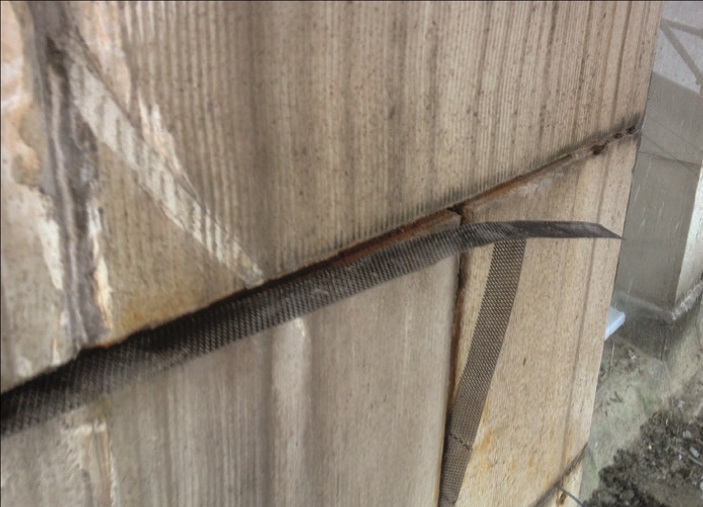 |
| Fig 6. A close-up of the ribbon anode being installed into the masonry joints (Photo: Chris Wozencroft) |
To conclude, Regent Street Disease affects a variety of buildings throughout the world and is particularly prevalent in the city centres of the UK. So long as the condition is properly diagnosed, it can be treated effectively. CP is one option but not the only one, and it may be possible to control corrosion simply by preventing moisture ingress. Each circumstance should be carefully considered. If CP is the correct solution, a variety of anodes, products and approaches are available to the designer to suit the circumstances.
All systems need to be monitored and maintained and, if done properly, this can limit the life-time cost of a building with Regent Street Disease. It is likely that there is a case study for every type of early 20th century structure and this experience can be used to determine which system, approach and products are correct for any given circumstance.
Further reading
The Corrosion Prevention Association publishes a useful series of technical notes, including Technical Note 7, Cathodic Protection of Early Steel-Framed Buildings (Peter Gibbs, 2016) – see www.corrosionprevention.org.uk/publications/. Articles by Chris Wozencroft can also be found on his website at www.corrosionengineering.co.uk/knowledge-library/. See also:
Chess, Paul M & Broomfield, John P [2014]. Cathodic Protection of Steel in Concrete & Masonry. CRC Press Taylor & Francis Group: USA. ISBN 978-0-415-39503-8
Clarke, Jonathan [ 2014]. Early Structural Steel in London. English Heritage: Swindon, England. ISBN 978-1-84802-103-7
Historic Scotland Technical Advice Note 20



